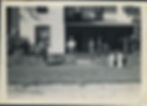African American Student Housing at the University of Illinois
- Jessica Ballard
- Feb 24, 2018
- 6 min read

As I began my faculty appointment at the University of Illinois Archives, I was given the privilege to finish a digital story map that graduate student Joseph Porto began. As part of the University of Illinois sesquicentennial celebration, students and staff, under the direction of Ellen Swain (director of the Student Life and Culture Archives), created an interactive story map with the help of the University of Illinois Scholarly Commons GIS team, directed by James Whitacre.
I was excited and also overwhelmed when given the opportunity to complete the story map on African American student housing. Extensive research had already been done. Graduate Assistant Joe Porto reviewed the Dean of Women Subject files, which documented addresses of some students. He also used city directories, which contained some of the student’s names and col. next to the name, which meant “colored.” Ellen also interviewed some of the individuals who were connected to community members with knowledge of this history. I spent many days researching at the University Archives in the Albert Lee collection. I had the opportunity to meet alums and scholars of the subject including Deirdre Cobb-Roberts and Vanessa Rouillon. I spoke with Barbara Suggs-Mason and Nathaniel Banks, both of whom had a wealth of information.
This research was put into the digital map, which is interactive. One side has the information regarding the families and their home. The other side has the map. As viewers scroll down, the map will automatically direct you to the house that you click, along with the content. The map itself is from 1936, and is part of the University of Illinois digital library collection.
The first section focuses on the community members who opened their homes to students. The second section is about the black greek letter organizations. The African American fraternities and sororities that were able to attain houses on campus were the earliest students to live on campus. It was challenging to find images of homes. Many of the homes that were present in the 1920s-1950s are no longer in existence. The Champaign County Historical Archives had most of the images used in this project. The Doris Hoskins collection at the Museum of the Grand Prairie had some images as well. The remainder of the images were donated by family members. The images of the fraternities and sororities were found in the Illio, mostly between the 1940s-1950s. I had the opportunity to interview some community members, many of whom had strong ties to the community as well as a connection to the U of I.
African American students have attended the University of Illinois at Urbana Champaign since the late 1800s. However, the struggles African Americans experienced in the early years of the University of Illinois history have generated little discussion. African Americans were a small minority on campus, and were also not permitted to live on campus. Furthermore, much of the University and Champaign-Urbana community has not known or recognized the generosity shown by community members who provided rooms to African American students. The African American community made it possible for students to receive their education at one of the premiere universities in the country.
African Americans were mostly confined to the “north end” of Champaign. A small population of students were admitted to the university as early as 1887 with Jonathan Rogan as the first African American student enrolled. George W. Riley enrolled in 1894. William Walter Smith was the first African American male to graduate from the university in 1900. Maudelle Tanner Brown was the first woman to graduate from the university in 1906.[1] By the 1920s more African Americans were recruited to the U of I, and more community members in the North End of Champaign made accommodations for students to live in their households.
It is challenging to determine how many African Americans attended the university before they were permitted to live on campus. Much of the information that is known comes from Albert Lee’s Negro Matriculate’s list. Albert Lee compiled a list of student’s names, addresses where students were housed off campus, and often indicated if they were affiliated with a black greek letter organization. Lee volunteered his time to create the list of approximately 900 students from the late 1920s through the late 1940s.[2] In the late 1920s Albert Lee and W.E.B. DuBois corresponded with one another. DuBois was the editor of the Crisis journal at the time (the journal of the National Advancement for the Achievement of Colored People (NAACP). This was also part of Lee’s motivation to construct the list.[3]
Albert Lee is revered as the individual most responsible for recruiting African American students, and finding a place for them to live. Lee was born on a farm near Champaign-Urbana. Lee completed his studies at Champaign High School in 1893. Two years later, he began working as a messenger boy for the U of I president Andrew Draper. Lee also attended the university briefly from 1897-1898.[4] As Lee became more involved in the university, he title was changed to Office Clerk and eventually to Chief Clerk. Lee served under 6 presidents with an office fifty feet from the president’s office. In the present day Lee is known as the Chief Clerk to the president and as the “Unofficial Dean of Black Students” for his dedication to the African American students. Students often came to Lee if they were having any challenges such as acquiring housing and mistreatment from professors. When Lee constructed the Negro matriculates list he often looked up addresses from the city and student directories. Lee also reached out to members in the community to see if students were being housed there. Lee kept the names in alphabetical order. He kept the lists starting with fraternities and sororities and kept them in the order of the years that the black greek letter organizations were founded (at the University of Illinois) starting with Kappa Alpha Psi Beta chapter, Alpha Phi Alpha Tau chapter, Alpha Kappa Alpha Gamma chapter, Omega Psi Phi Pi Psi chapter, and Delta Sigma Theta Alpha Nu chapter. Kappa Alpha Psi attained their first home on Clark street around 1914. The exact date of Alpha Phi Alpha’s home is not clear, but their home on Clark St. shows up the Illios in the 1940s. Alpha Kappa Alpha had a home by 1922 on Stoughton St, and Delta Sigma Theta acquired a house on Oregon St. in 1952.[5]
Research on this topic has been done since the 1990s. Deirdre Cobb-Roberts dissertation Race and Higher Education at the University of Illinois 1945-1955 was one of the earliest works that discusses African American student housing. Cobb-Roberts utilized Lee’s papers from the University Archives, as part of research. She also had interactions with people in the community who had a connection with her research. In the fall of 2017 Cobb-Roberts returned to the university and hosted a panel with people related to some of the members that she interviewed for her dissertation. Featured in the panel was Nathaniel Banks (Albert Lee’s grand-nephew), Angela Rivers, and Barbara Suggs-Mason. Before the discussion the short film A Home of Their Own was premiered which included interviews of all three of the panelist, and some alums who were forced to live on the North end of Champaign in the 1940s.
Vanessa Rouillon completed her dissertation in 2013 regarding Albert Lee and the Bethel A.M.E.’s contribution in fostering a safe environment for black students. Professor Rouillon became interested in Albert Lee and Bethel A.M.E. from her visit to the University Archives for a class on race and literacy. Though Professor Rouillon has completed her dissertation, her research continued after graduation and had led her to explore Lee’s institutional and church race work in depth. She has taken on the role as Albert Lee’s biographer and is working on publishing Lee’s manuscripts with some of her scholarly commentary on Lee’s racial work. Furthermore, Professor Rouillon has returned to the university and has worked diligently to have Lee’s headstone replaced. Lee is buried at the Mt. Hope Cemetery along with other close family members. However, only a dilapidated foundation remains, making Lee’s resting place challenging to find. On August 24th, Professor Rouillon and the Bethel A.M.E. church will have a ceremony at Lee’s grave and will dedicate a new tombstone; this unveiling will be followed by an exhibit of Lee’s papers the University Archives, and a lyceum evening at Bethel A.M.E. Church. Most notably, Lee’s family in Oklahoma, Texas, and California will attend all events.
The University of Illinois, will also contribute to the cost of the tombstone and will help to host the event. In the fall of 2018 a short film funded by chancellor’s diversity public engagement office on Albert Lee will premiere with a script and footage constructed by Vanessa Rouillon. The film will also include some of Lee’s family’s connections. More details about the film will be given closer to its premiere which is expected to be in November.
I am still finding content to add to the digital story map. The Student Life and Culture Archives (a component of the University of Illinois Archives), is also working on an oral history series which was inspired from some of the people interviewed for the project. If you have any information regarding early African American student housing please contact Jessica Ballard the Visiting Faculty Archives Resident ballard9@illinois.edu.
[1] Deirdre Cobb- Roberts Race and Higher Education at the University of Illinois 1945-55. 1998 (dissertation). “The University of Illinois Negro Students Location, History and Administration.” President A.C. Willard Papers, Record Series 2/9/1 Box 42, University of Illinois Archives, Urbana, Illinois.
[2] Negro Matriculates List Record Series 2/9/16
[3] University of Illinois Archives Albert R. Lee Papers Box 1
[4] Vanessa Rouillon Reconfiguring Racial Uplift: Church-Sponsored African American Rhetorical Work in the Early Twentieth Century 2013 (dissertation).
[5] University of Illinois Archives Negro Matriculates List Record Series 2/9/16
.jpg)

























